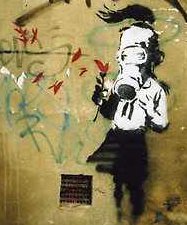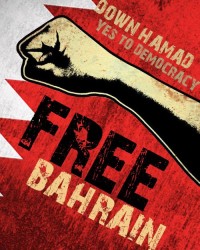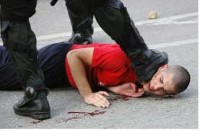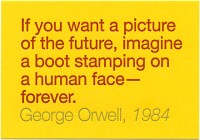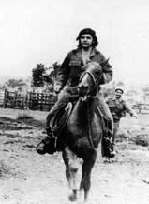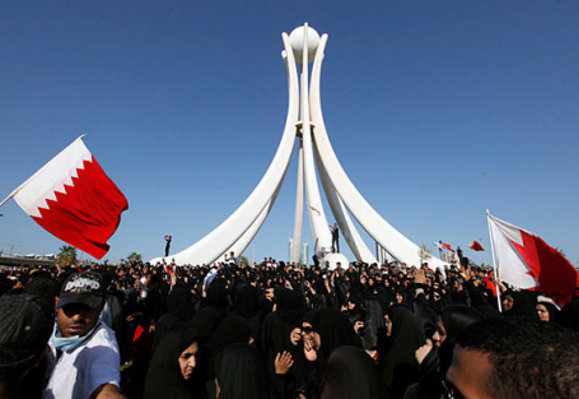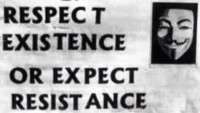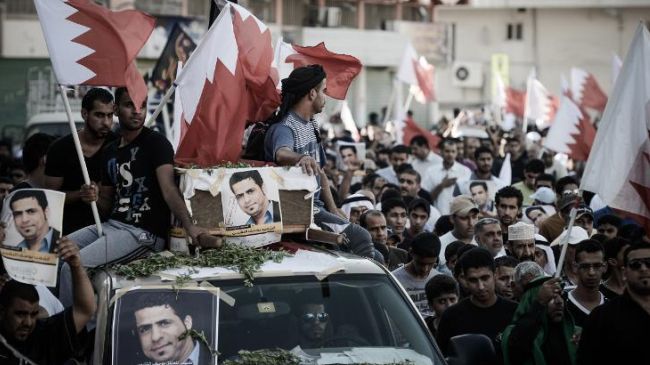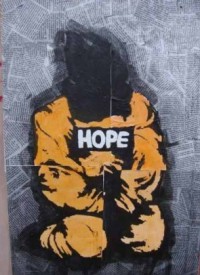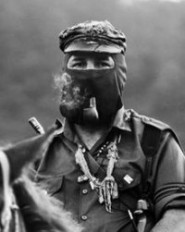Fair trials impossible in Bahrain’s military court
Bahrain: New Evidence of Framed-up Death Sentences Against Pro-Democracy Activists
Ministry of Interior Whistle-blower Suggests Murder Trial Used For Political Dirty Tricks
by Finian Cunningham – Global Research, September 23, 2011
New evidence has emerged that the Bahraini regime’s case against two pro-democracy activists sentenced to death for killing a pair of police officers is seriously flawed. In the latest twist of the controversial murder trial, an employee of Bahrain’s Ministry of Interior has now spoken out to clear the names of the men awaiting execution.
The alleged killing of the two policemen occurred during the crackdown against pro-democracy protests in the US-backed Persian Gulf kingdom earlier this year. The event was seen as a tipping point that paved the way for an escalation in repression against civilians by Bahraini and Saudi forces, resulting in dozens of deaths and mass detentions.
Five other Bahraini men were sentenced to life imprisonment for their participation in the alleged murder of the police officers in which the state prosecution claimed that pro-democracy activists deliberately drove vehicles over the victims as they lay prostrate on open ground.
The gruesome deaths were apparently captured on amateur video and are alleged to have occurred on 16 March, the same day that Saudi-led troops began their violent crackdown on pro-democracy protests in the Bahraini capital, Manama. The video was subsequently aired on government-controlled Bahrain TV and caused widespread revulsion among the public [1].
The two men sentenced to death – 19-year-old Ali Al Singace and 24-year-old Abdulaziz Husain – are to be executed by firing squad if their appeals are rejected next month.
Human rights activists and the families of the sentenced men say that they were set up by the Bahraini regime. They point out that the accused men were not associated with each other before or at the time of the alleged crime and that they come from different villages across Bahrain. The only thing that links the men is that they were active in political demonstrations in their respective villages. Campaigners for the men say that the trial was driven by political motives: to intimidate pro-democracy activists; to smear the mainly Shia-led uprising; and to justify the calling of a state of emergency by the unelected Sunni regime and subsequent violent crushing of protests.
Firstly, campaigners for the sentenced men point out that, apart from the video, the only other evidence used to convict the accused were their confessions. Nabeel Rajab of the Bahrain Centre for Human Rights says the confessions were obtained from the defendants after they were tortured during several weeks of illegal detention [2]. Rajab also points out that the men were denied legal defence; two days before their trial before a military court began, Mohammed Al Tayer, a lawyer appointed to defend the men, was himself arrested and imprisoned by the regime. When the defendants appeared in court, they retracted their confessions.
Secondly, the veracity of the amateur video apparently showing two vehicles driving over a policeman’s body has been called into question. While the initial airing of the video on Bahrain TV sparked public horror at the brutality, subsequent closer examination of the footage by legal sources has highlighted several flaws indicating that the incident was a fabrication.
For example, after the vehicles ran over one of the figures alleged to be a policeman’s body, a group of youths is seen to mysteriously arrive on the scene and begin “violating” the corpse by kicking it and pelting it with stones. The macabre scenario has a distinctly scripted appearance. In one frame, part of the corpse is seen to effortlessly lift off the ground after being kicked, suggesting that the figure on the ground is not a human dead weight, but rather a dummy [3].
There are several other anomalies undermining the credibility of the prosecution video. Critics note that the vicinity of the incident was hours earlier on that morning swamped with Bahraini, Saudi and other Gulf forces who had moved in to clear protesters from the nearby Pearl Monument, which had been a focal point for pro-democracy demonstrations. It defies belief that youths could have casually carried out the lynching of police officers in an open car park only metres from the Pearl Monument, which had by then become occupied by state forces. Indeed, freeze-frame examination of wide-angle shots in the video, show the heavy presence of state forces along the top perimeter of the scene.
Also, how did two police officers end up isolated from thousands of other troops? Why is no blood seen staining the ground underneath the prostrate figures after they were repeatedly run over and then violated by the crowds?
Furthermore, the vehicles that were alleged to have been involved in the killings were never recovered for evidence, nor were any forensics from the vehicles produced. One of the two men sentenced to death, Ali Al Singace, was later shown to have had a broken leg at the time of the alleged incident in which he was supposed to have driven in one of the vehicles.
At the time of the prosecution, pro-government Bahraini media published photographs and names of two police officers, whom, it was claimed, were the victims of the lynching. There were named as Kashef Mandhoor and Mohammed Al Balooshi. But there is widespread suspicion among Bahrainis that the dead officers were not killed under the circumstances claimed by the state prosecutor in the murder trial. One theory is that the policemen may have actually been killed by the regime for not taking part in the murderous crackdown against peaceful protesters, and that their identities were subsequently adopted for the purpose of prosecuting the seven pro-democracy activists.
Now, a Ministry of Interior employee, named as Ahmed Mansour, has testified in a video made by the Bahrain Centre for Human Rights that he was present during the incident where the police officers are claimed to have been killed [4]. Mansour’s testimony has been translated from Arabic to English for Global Research. He claims to be the plainclothed individual who can seen in the prosecution’s video picking up a shotgun lying on the ground near a prostrate figure and running over to a getaway vehicle.
Mansour does not explicitly say whether the figure on the ground was a dummy or not, or whether the whole scenario was a fabrication. But what he does say clearly is that the seven men sentenced for the police murders were not present at the incident. The men are alleged to have driven the two vehicles used in running over the police officers. But the Ministry of Interior employee is now flatly contradicting this claim. He says that none of the accused was in either of the two vehicles.
It is hard not to draw the conclusion that the whole prosecution has been a vile fabrication; a show trial whose real purpose was to impugn the entire Bahraini political opposition. Disgracefully, in order for the US-backed Bahraini regime to achieve that objective two innocent young men are facing firing squads and five others are languishing for life in prison.
In the same week that the Ministry of Interior whistleblower made his claims suggesting the wrongful conviction and sentencing to death of the Bahraini men, the king of the Persian Gulf state was addressing the United Nations in New York. King Hamad bin Isa Al Khalifa assured UN delegates that his kingdom respects “universal human rights” – not, it seems, if they are the rights of pro-democracy activists.
Finian Cunningham is a Global Research Correspondent based in Belfast, Ireland. He was expelled from Bahrain for his critical journalism on 18 June 2011. …source



